engine oil OLDSMOBILE INTRIGUE 1998 Owners Manual
[x] Cancel search | Manufacturer: OLDSMOBILE, Model Year: 1998, Model line: INTRIGUE, Model: OLDSMOBILE INTRIGUE 1998Pages: 340, PDF Size: 17.93 MB
Page 7 of 340
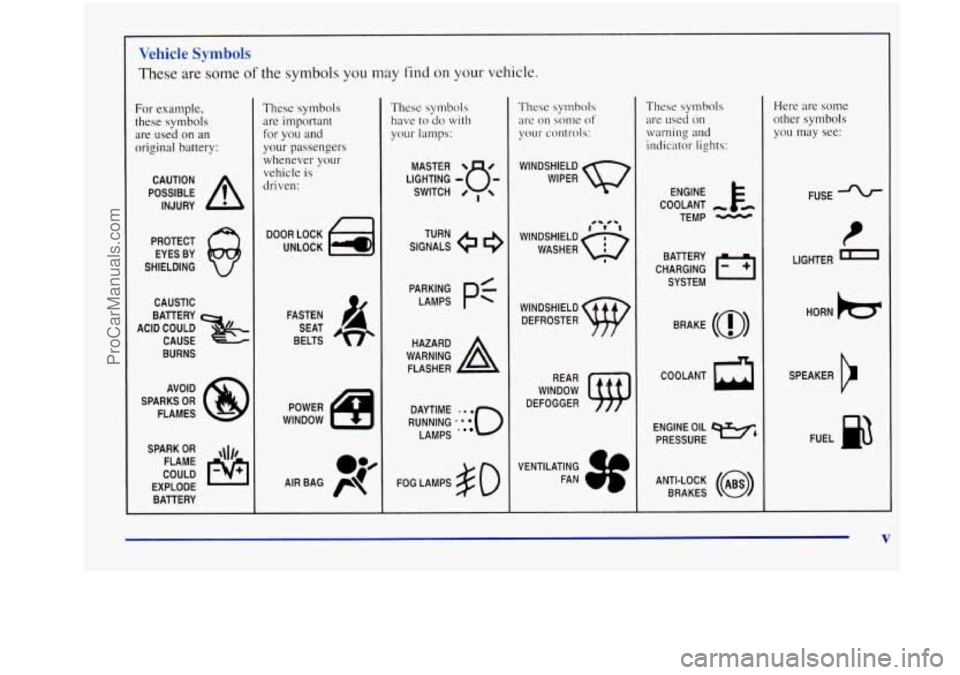
These are some of the symbols you may find on your vehicle.
For example,
these symbols
are used on an
original battery:
POSSIBLE A
CAUTION
INJURY
PROTECT EYES BY
SHIELDING
CAUSTIC
BURNS
SPARK
OR ,\I/,
COULD FLAME
EXPLODE BATTERY
These symbols are important
for you and
your passengers
whenever your
vehicle is
driven:
DOOR LOCK
UNLOCK
a
FASTEN SEAT
BELTS
These symbols have
to do with
your lamps:
SIGNALS e
TURN
RUNNING
*':**o
DAYTIME LAMPS
FOG LAMPS $0
These symbols
;II% on some of
your controls:
WINDSHIELD
WIPER
WINDSHIELD DEFROSTER
WINDOW
DEFOGGER
VENTILATING FAN
These symbols are used on
warning and
indicator lights:
COOLANT -
TEMP -
CHARGING I-1
BATTERY
SYSTEM
BRAKE
(0)
ENGINE OIL e,
PRESSURE
ANTI-LOCK
(@)
BRAKES
Here are some
other symbols
you may see:
FUSE
LIGHTER
n
HORN )b(
SPEAKER
b
FUEL m
V
ProCarManuals.com
Page 79 of 340

To Use the Engine Coolant Heater
1. Turn off the engine.
2. Open the hood and unwrap the electrical cord. The
cord is located near the air cleaner assembly.
3. Plug it into a normal, grounded 110-volt AC outlet.
IN:
I-
-
Plugging the cord into an ungrounded outlet
could cause an electrical shock. Also, the wrong
kind
of extension cord could overheat and cause
a fire. You could be seriously injured. Plug the
cord into
a properly grounded three-prong
110-volt AC outlet.
If the cord won’t reach, use a
heavy-duty three-prong extension cord rated for
at least
15 amps.
4. Before starting the engine, be sure to unplug and
store the cord as it was before to keep it away
from moving engine parts.
If you don’t, it could
be damaged.
How long should you keep the coolant heater plugged
in? The answer depends on the outside temperature, the
kind
of oil you have, and some other things. Instead of
trying to list everything here, we ask that
you contact
your retailer
in the area where you’ll be parking your
vehicle.
The retailer can give you the best advice for that
particular area.
ProCarManuals.com
Page 122 of 340
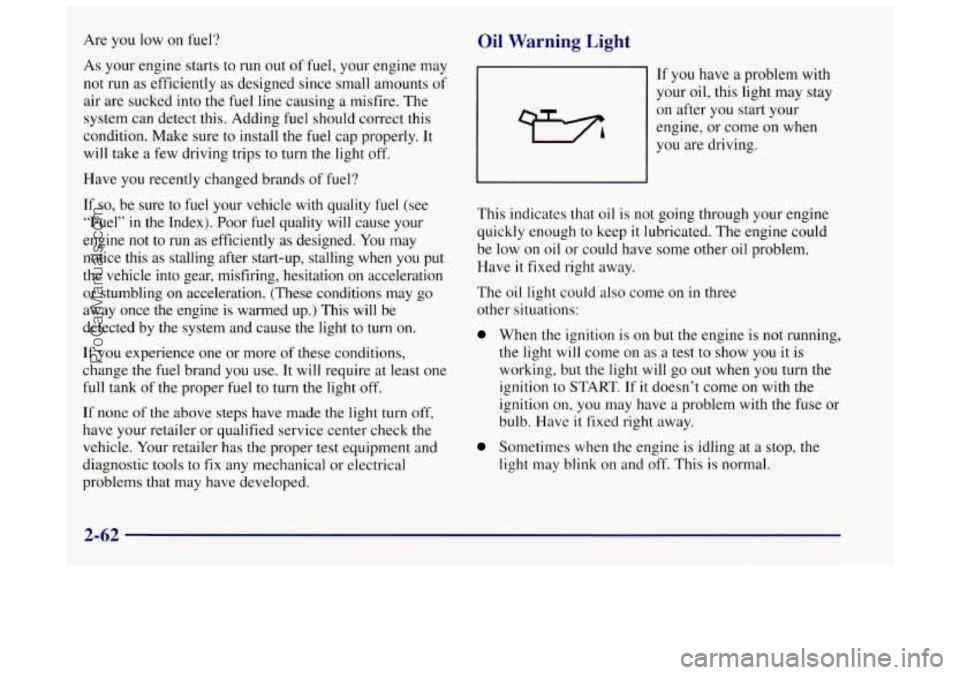
Are you low on fuel? Oil Warning Light
As your engine starts to run out of fuel, your engine may
not run as efficiently as designed since small amounts of
air are sucked into the
fuel line causing a misfire. The
system can detect this. Adding fuel should correct this
condition. Make sure to install the
fuel cap properly. It
will take a few driving trips
to turn the light off.
Have
you recently changed brands of fuel?
If
so, be sure to fuel your vehicle with quality fuel (see
“Fuel”
in the Index). Poor fuel quality will cause your
engine not
to run as efficiently as designed. You may
notice this as stalling after start-up, stalling when you put
the vehicle into gear, misfiring, hesitation
on acceleration
or stumbling on acceleration. (These conditions may go
away once the engine is warmed up.) This will be
detected by the system and cause the light to turn on.
If you experience one or more
of these conditions,
change the fuel brand you use. It will require at least one
full tank of the proper fuel to turn the light off.
If none
of the above steps have made the light turn off,
have your retailer
or qualified service center check the
vehicle. Your retailer has the proper test equipment and
diagnostic tools to
fix any mechanical or electrical
problems that may have developed. If
you have a problem with
your oil, this light may stay
on after you start your
engine, or come on when
you are driving.
This indicates that oil is not going through your engine
quickly enough to keep it lubricated. The engine could
be low on oil or could have some other oil problem.
Have
it fixed right away.
The oil light could also come on
in three
other situations:
When the ignition is on but the engine is not running,
the light will come
on as a test to show you it is
working, but
the light will go out when you turn the
ignition to START.
If it doesn’t come on with the
ignition on, you may have a problem with
the fuse or
bulb. Have it fixed right away.
Sometimes when the engine is idling at a stop, the
light may blink on and off. This is normal.
2-62
ProCarManuals.com
Page 123 of 340

If you make a hard stop, the light may come on for a
moment. This
is normal.
-
Don’t keep driving if the oil pressure is low. If
you do, your engine can become
so hot that it
catches fire. You or others could be burned.
Check your oil as soon as possible and have your
vehicle serviced.
NOTICE:
Damage to your engine from neglected oil
problems can be costly and is not covered by
your warranty.
Low Oil Level Light
LOW
OIL
~ Your engine is equipped
1 with an oil level monitoring
l system. When the ignition is
turned on, the
LOW OIL
~ level light will briefly flash.
If the light does not flash, have it fixed
so it will be
ready
to warn you if there’s a problem.
If the light stays on, stop the vehicle on
a level surface
and turn the engine off. Check the oil level using the
engine oil dipstick. (See “Engine Oil” in the Index.) If
the light does not flash, have the low oil level sensor
system repaired
so it will be ready to warn you if there’s
a problem.
The oil level monitoring system only checks oil level
during the brief period between key on and engine
crank.
It does not monitor engine oil level when the
engine
is running. Additionally, an oil level check is
only performed
if the engine has been turned off for a
considerable period of time, allowing the oil normally
in
circulation to drain back into the oil pan.
2-63
ProCarManuals.com
Page 124 of 340
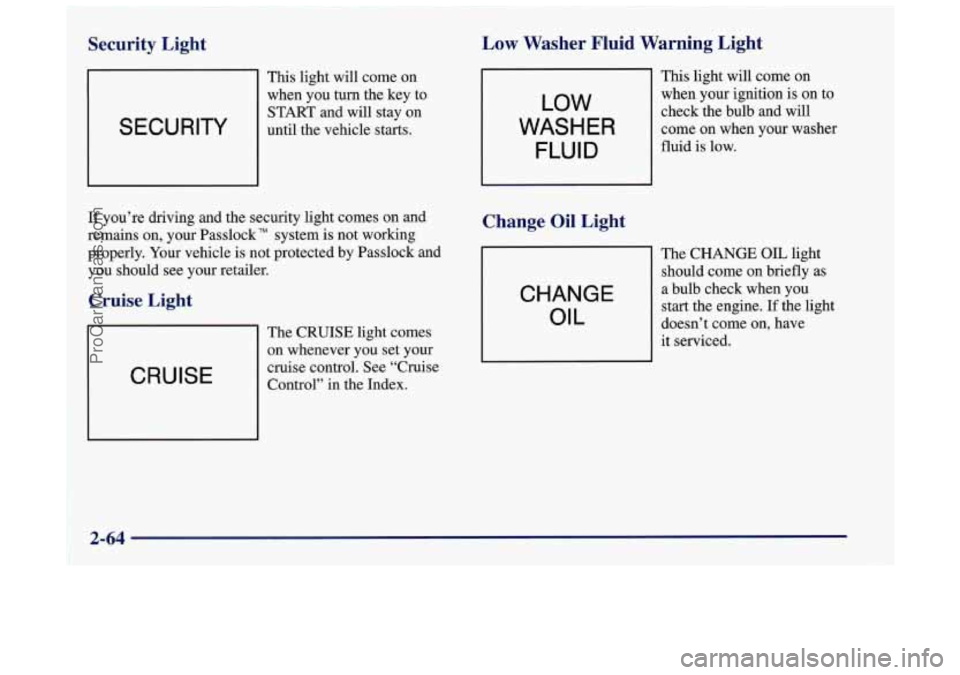
Low Washer Fluid Warning Light
Security Light
SECURITY
This light will come on
when you turn the key to
START and will stay on
until the vehicle starts.
LOW
WASHER
FLUID
If you’re driving and the security light comes on and
remains on, your Passlock” system is not working
properly. Your vehicle is not protected by Passlock and
you should see your retailer.
Cruise Light
CRUISE
The CRUISE light comes
on whenever you set your
cruise control. See “Cruise
Control” in the Index.
This light will come on
when your ignition is on to
check
the bulb and will
come on when your washer
fluid
is low.
Change Oil Light
CHANGE
OIL
The CHANGE OIL light
should come on briefly as
a bulb check when you
start the engine.
If the light
doesn’t come
on, have
it serviced.
2-64
ProCarManuals.com
Page 125 of 340

If the CHANGE OIL light comes on and stays on after
you
start the engine, have the oil changed. The light may
indicate to change the oil sooner than suggested in your
maintenance schedule, depending on your driving patterns.
This light will come on when the system predicts that the
oil’s remaining useful life is almost up. It alerts you to
change the oil on a schedule consistent with your vehicle’s \
driving conditions. Therefore,
you should change your oil
at the intervals recommended in your maintenance
schedule or when the CHANGE
OIL light comes on,
whichever comes first. See “Engine Oil, When to Change”
and “Maintenance Schedule,” in the Index.
To reset the CHANGE
OIL light, see “Engine Oil” in
the Index.
Fuel Gr 2
0
Your fuel gage tells you
about how much fuel
you
have left when the ignition
is on. When the indicator
nears EMPTY
(E), you still
have a little fuel left,
but
you should get more soon.
Here are some things owners ask about. All these
situations are normal and do not show
a problem with
your fuel gage:
At the service station, the pump shuts off before the
gage reads
FULL (F).
It takes a little more or less fuel to fill up than the gage
indicated.
For example, the gage may have indicated
the tank was half full, but it actually took a little more
or less than half
the tank’s capacity to fill it.
The gage moves a little when you turn the corner or
speed
up.
2-65
ProCarManuals.com
Page 176 of 340

Once you are moving on the freeway, make certain you
allow a reasonable following distance. Expect to move
slightly slower at night.
When you want to leave the freeway, move to the proper
lane well in advance. If
you miss your exit, do not,
under any circumstances, stop and back up. Drive on to
the next exit.
The exit ramp can be curved, sometimes quite sharply.
The exit speed is usually posted.
Reduce your speed according to your speedometer, not
to your sense of motion. After driving for any distance
at higher speeds, you may tend to think you are going
slower than
you actually are.
Befi- ~ Leaving on a Long Trip
Make sure you’re ready. Try to be well rested. If you
must start when you’re not fresh -- such as after a day’s
work
-- don’t plan to make too many miles that first part
of the journey. Wear comfortable clothing and shoes
you
can easily drive in.
Is your vehicle ready for a long trip? If you keep it
serviced and maintained, it’s ready to go.
If it needs service, have
it done before starting out. Of course,
you’ll find experienced and able service experts in
Oldsmobile retail facilities all across
North America.
They’ll be ready and willing to help if you need it.
Here are some things
you can check before a trip:
0
0
0
0
0
0
0
Windshield Washer Fluid: Is the reservoir full? Are
all windows clean inside and outside?
Wiper Blades: Are they in good shape?
Fuel, Engine Oil, Other Fluids: Have you checked
all levels?
Lamps: Are they all working? Are the lenses clean?
Tires: They are vitally important to a safe,
trouble-free trip.
Is the tread good enough for
long-distance driving? Are the tires all inflated to
the recommended pressure?
Weather Forecasts: What’s the weather outlook
along your route? Should you delay your trip a
short time to avoid a major storm system?
Maps: Do you have up-to-date maps?
4-22
ProCarManuals.com
Page 191 of 340

When You Are Ready to Leave After
Parking on a Hill
1. Apply your regular brakes and hold the pedal down
while you:
Start your engine;
Shift into a gear; and
Release the parking brake.
2. Let up on the brake pedal.
3. Drive slowly until the trailer is clear of the chocks.
4. Stop and have someone pick up and store the chocks.
Maintenance When Trailer Towing
Your vehicle will need service more often when you’re
pulling a trailer. See the Maintenance Schedule for more
on this. Things that are especially important in trailer
operation are automatic transaxle fluid (don’t overfill),
engine oil, drive belts, cooling system and brake
adjustment. Each of these
is covered in this manual,
and the Index will help you find them quickly. If you’re
trailering, it’s a good idea to review this information
before you start your trip.
Check periodically to see that all hitch nuts and bolts
are tight.
Engine Cooling When Trailer Towing
Your cooling system may temporarily overheat during
severe operating conditions. See “Engine Overheating”
in the Index.
4-37
ProCarManuals.com
Page 209 of 340
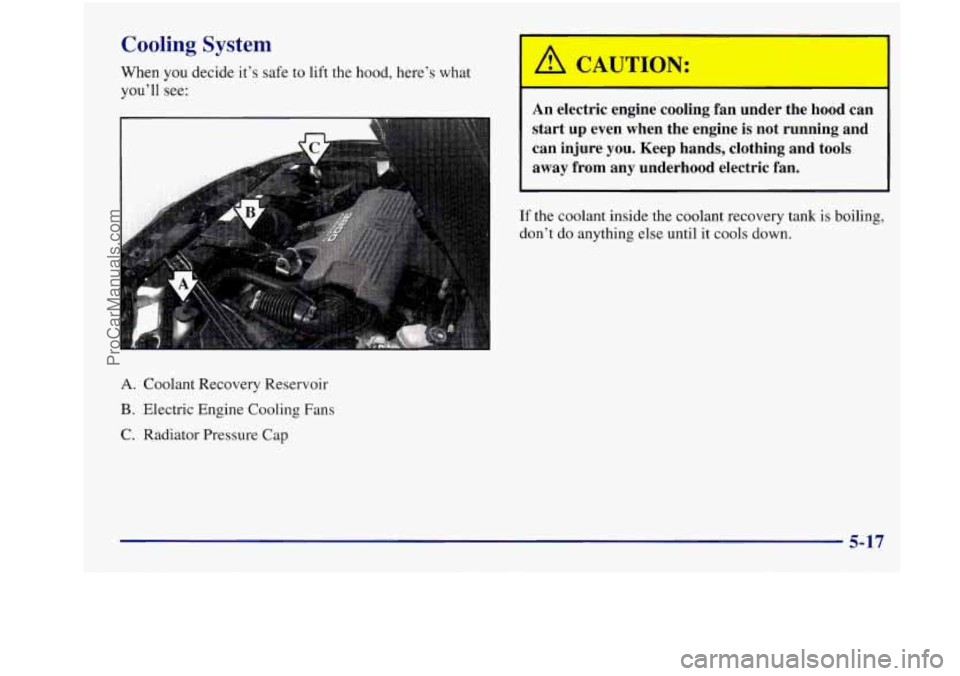
Cooling System
When you decide it’s safe to lift the hood, here’s what
you’ll see:
A. Coolant Recovery Reservoir
B. Electric Engine Cooling Fans
C. Radiator Pressure Cap
I A CAUTION:
An electric engine cooling fan under the hood can
start up even when the engine is not running and can injure you. Keep hands, clothing and tools
away from any underhood electric fan.
If the coolant inside the coolant recovery tank is boiling,
don’t do anything else until
it cools down.
5-17
ProCarManuals.com
Page 211 of 340
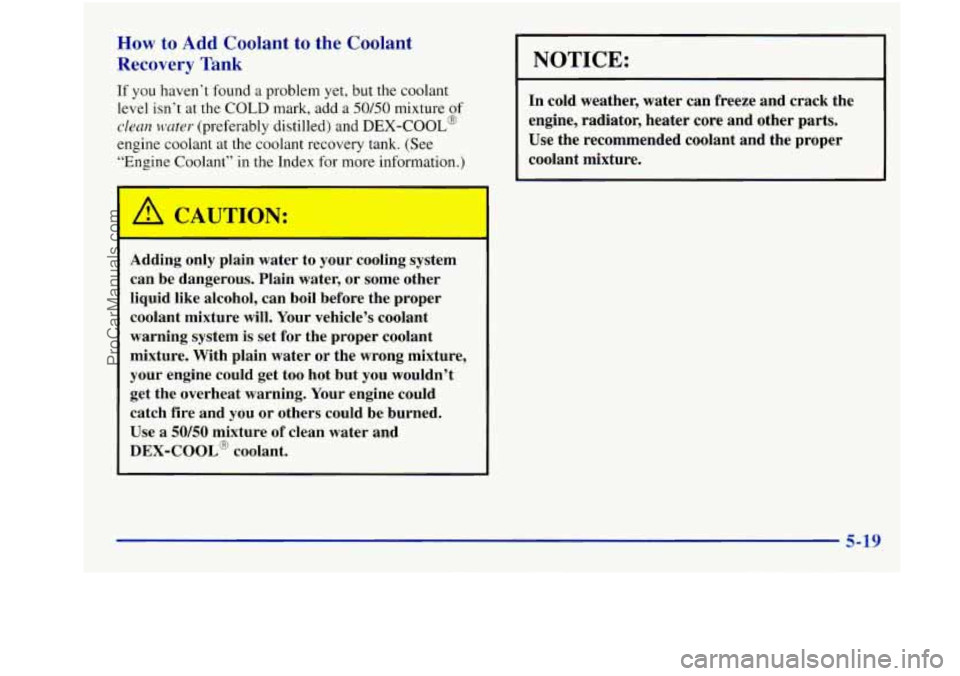
How to Add Coolant to the Coolant
Recovery Tank
If you haven’t found a problem yet, but the coolant
level isn’t at
the COLD mark, add a 50/50 mixture of
clean water (preferably distilled) and DEX-COOL@
engine coolant at the coolant recovery tank. (See
“Engine Coolant” in the
Index for more information.)
Adding only plain water to your cooling system can be dangerous. Plain water, or some other
liquid like alcohol, can boil before the proper
coolant mixture will. Your vehicle’s coolant
warning system is set for the proper coolant
mixture. With plain water or the wrong mixture,
your engine could get too hot but you wouldn’t
get the overheat warning. Your engine could
catch fire and you or others could be burned.
Use
a 50/50 mixture of clean water and
DEX-COOL@ coolant.
NOTICE:
In cold weather, water can freeze and crack the
engine, radiator, heater core and other parts.
Use the recommended coolant and the proper
coolant mixture.
5-19
ProCarManuals.com